
* The British were leaders in aircraft design through the Second World War, but suffered a slow decline in their aerospace and defense capabilities after the war due to economic constraints and political indifference. In recent decades, British aerospace and defense manufacture has revived, aggressively exporting military aircraft and advanced weaponry. One of their biggest successes has been the British Aerospace (BAE) "Hawk" -- a trainer and light combat aircraft that has been adopted by many of the world's armed services, including the US Navy. This document provides a history and description of the Hawk. A list of illustration credits is included at the end.

* In the early 1960s, the British Royal Air Force (RAF) was operating two jet trainer aircraft: the Hawker Hunter T.7 two seat side-by-side trainer, and the Folland Gnat T1.
The Hunter trainer was well liked, but it was also expensive to operate; had limited endurance; and its side-by-side seating arrangement was increasingly seen as outdated. Side-by-side seating is well suited for primary training, since it gives the instructor a close view of what the student pilot is doing, but is poorly suited to advanced training, since it creates a cockpit environment dissimilar to that of the single-seat aircraft the student is presumably being trained to fly.
Although the Gnat T1 was appreciated for its agility and good handling, and achieved recognition as the mount for the RAF Red Arrows aerobatic display team, it suffered from high maintenance overhead; a cramped cockpit that could not accommodate tall pilots, and left the flight instructor straining to see forward through the back of the student's head; and no weapons training capability.
In 1964, the RAF released a draft requirement for a trainer to replace both the Hunter trainers and the Gnat T1, with the designation "Air Staff Target (AST) 362". Transition to the new trainer was to begin in the mid-1970s. In step with the spirit of the times, the new trainer was to have a top speed of Mach 1.5. It hadn't been realized yet that the benefits of a supersonic trainer did not strongly outweigh the drawbacks of higher purchase and operation costs.
Then international politics intervened. The French were also interested in a new trainer to replace their Lockheed T-33 "T-birds" and Dassault Mystere IVs, and a round of typically complicated Anglo-French negotiations followed. These discussions led off in one direction to the Anglo-French SEPECAT Jaguar, which was originally conceived as a trainer and light strike aircraft. Ultimately, the Jaguar became very much a competent strike fighter, but was simply too much aircraft for cadet training. Tandem-seat Jaguars were built, but they were used for operational conversion, not flight instruction.
Another offshoot of this round of discussions were a series of proposals made to the RAF in 1968 by Hawker Siddeley Aircraft (HSA) for a jet trainer. By this time, the RAF's focus had shifted somewhat towards a replacement for the Huntington Jet Provost T.5 trainer, and HSA was also looking very seriously at the broader international market to replace aging trainers such as the Jet Provost, T-33, and Macchi MB.326. The market for new jet trainers was estimated at thousands of aircraft -- excluding the US, which rarely "bought foreign", and the Eastern Bloc, where political barriers ruled out the sale of Western aircraft.
HSA gave their studies the designation "HS.1182". The new trainer was to have armament capability so that it could be used for weapons training, as well as for light combat duties. Early concepts envisioned a single-engine, tandem-seat aircraft with straight, low-mounted wings, with some resemblance to the Macchi MB.326 trainer.
In 1969, the British Ministry of Defense gave the ball another push by issuing requirement "AST.397" for a tandem seat, single engine, subsonic jet trainer with weapons capability and an unprecedented 6,000-hour airframe fatigue life. This specification was open to international competition and was by no means written around the HS.1182 specification, but gradually the competitors, in the form of aircraft such as the Dassault-Dornier Alpha Jet and proposals by British Aircraft Corporation (BAC), fell out, and in October 1971 the HSA proposal was accepted. That led to a production contract early the next year for 176 trainers, with the first to be delivered in late 1976.
With the beginning of full scale development, HSA assigned Gordon Hudson as chief designer, and confusingly assigned Gordon Hodson as the assistant chief designer. Both men were ex-Folland personnel. The design was given the name "Hawk". Although traditionally British trainers had, logically but a bit stuffily, been named after educational establishments, "Hawk" was a simple name, and easy to put in flight logbooks; the RAF Staff College emblem featured the Egyptian hawk god Horus; and apparently there were officials who also thought that naming aircraft after universities was a bit stuffy, or at least wouldn't have much appeal for export sales.
The design that was finalized during development modified earlier concepts by providing a slightly swept wing, with the engine intakes mounted above the wing roots. Shoulder-mounted intakes had been considered earlier, but wind tunnel tests indicated stability problems with that configuration. In any case, the design team had good reason to feel pleased with the machine, since it had clean and elegant lines. The first "Hawk T1", painted in snappy red and white colors, flew on 21 August 1974, with test pilot Duncan Simpson at the controls. A number of defects were discovered in flight test and corrected, but these were ordinary development and teething problems, the Hawk's design being fundamentally sound.
BACK_TO_TOP* The Hawk that emerged from the development process was not merely a good-looking aircraft; it was agile and handled well, with clean responsiveness to controls, pilots finding it great fun to fly. It was capable of transonic speeds in a dive, which apparently came as something of a surprise to its designers. It had long range and endurance, was economical to operate, and would acquire an excellent safety record. The Hawk was also a relatively quiet aircraft as military jets go, and ambient cockpit noise was low, improving communications between instructor and student.
As mentioned, the Hawk was a tandem-seat trainer with a low-mounted, slightly swept wing, a single engine with inlets above the wing roots, and a conventional tail assembly. It had tricycle landing gear, with all gear assemblies featuring single wheels. The nose gear retracted forward, while the wide-track main gear hinged in the wings towards the fuselage; the nose wheel castored but was not steerable, ground steering being performed by differential mainwheel braking. The aircraft was of conventional construction, built mostly of aluminum alloy, with some use of magnesium to save weight. Interestingly, the Hawk was the first British aircraft to be designed in metric instead of English units.
The wing featured outboard ailerons and inboard double slotted flaps. The tailplane was all-moving. There were also twin fixed ventral fins under the tail; these were significantly shorter in early prototype machines. There was a single airbrake in the belly in front of the two ventral fins -- that cost less than twin airbrakes, but it couldn't be extended while landing. Flight controls and landing gear were powered by duplicate hydraulic systems.
The aircraft was designed to allow fit of five stores pylons, with one on the centerline and two on each wing, though RAF Hawk trainers would never use more than one stores pylon on each wing. The extra attachment point on each wing was specified to permit flexibility for export sales. The inner attachment points were plumbed for drop tanks. For weapons training, the Hawk could be fitted with a centerline gun pod -- similar to those fitted to British Harrier jump jets, with a single 30-millimeter Aden Mark 4 cannon with 120 rounds -- and a stores pylon under each wing for munitions. Pylon loads included practice bomb carriers and SNEB / Brandt rocket pods, or a pair of 455-liter (120 US gallon) drop tanks. External load in practice was restricted to 680 kilograms (1,500 pounds).
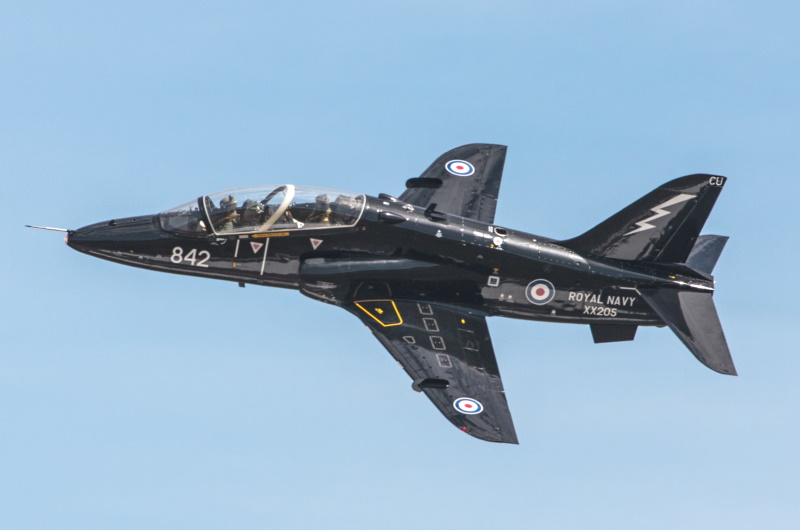
Although the Rolls-Royce Viper 632 turbojet was initially considered as the powerplant, the final choice was the Rolls-Royce / Turbomeca Adour 151 non-afterburning turbofan with 23.15 kN (2,360 kgp / 5,200 lbf) thrust. The Adour had been developed for the Jaguar. While the Adour cost much more than the Viper, the Adour was a more modern engine that had better fuel economy; had an estimated 95% parts commonality with the afterburning Adour 102s used in the Jaguar; and was regarded, correctly as it turned out, as offering more improvement potential than the mature Viper engine, while still having been proven in the Jaguar.
The Adour engine dropped out of the Hawk's belly for service, and in principle could be replaced in 90 minutes. The Hawk was built with serviceability in mind, with almost a third of the aircraft's surface covered by access panels. A Microturbo 047 Mark 2 Gas Turbine Starter / Auxiliary Power Unit (GTS/APU) was installed above the engine to permit self-starting and to assist in relights after an in-flight flame-out. If the aircraft lost power in flight, a ram-air turbine automatically popped up in front of the tailfin to provide emergency electrical power.
The cockpit was very comfortable in comparison to the Gnat's, with the back seat stepped up to give the flight instructor a clear view over the top of the student's head. There was a windscreen between the front and back seat to protect the back-seater from windblast in case of a bird strike or other front-canopy failure. The canopy was single-piece and hinged open to the right. The T1's cockpit controls were analog and relatively simple. A Ferranti ISIS gunsight was fitted.
While HSA had wanted to use the new lightweight Folland-Saab Mark 4GT ejection seats, the RAF specified the bigger and heavier Martin-Baker Mark 10B rocket boosted zero-zero ejection seats to maintain commonality with other RAF aircraft. The larger Martin-Baker seats required a slight fuselage stretch from the original paper design to permit their accommodation. The canopy was taped with miniature detonation cord to shatter it before ejection.
___________________________________________________________________
HAWK T1:
___________________________________________________________________
wingspan:
9.39 meters (30 feet 10 inches)
wing area:
16.69 sq_meters (179.60 sq_feet)
length:
11.85 meters (38 feet 11 inches)
height:
4 meters (13 feet 1 inch)
empty weight:
3,635 kilograms (8,010 pounds)
max loaded weight:
8,340 kilograms (18,390 pounds)
maximum speed:
1,040 KPH (658 MPH / 572 KT)
service ceiling:
15,250 meters (50,000 feet)
range (internal fuel):
2,400 kilometers (1,490 MI / 1,295 NMI)
___________________________________________________________________
* Only one pre-production Hawk was built. Five more were used for development, but they were later brought up to production standard and passed on as part of the RAF contract. HSA retained an early-production Hawk as a company demonstrator, with this aircraft undergoing a wide range of mutations over the years.
The first Hawk T1 to be formally accepted by the RAF was delivered in November 1976, with the last delivered in March 1982. As might be expected, some deficiencies were uncovered after the Hawk went into service. Some faults, such as a nosewheel that swiveled poorly, were corrected in later development; and some economy measures, such as low-cost radios, proved unacceptable in practice and had to be upgraded later. By the time of the last delivery, the Hawk was the "BAE Hawk", since HSA had been absorbed into the British Aerospace group in the spring of 1977.
The first user was the RAF flight instruction unit at RAF Valley on the island of Anglesey off the coast of Wales, followed by other RAF organizations such as the weapons training units at RAF Brawdey and Chivenor, and also units of the Royal Navy's Fleet Air Arm. Over time, defense consolidation has tended to accumulate the Hawk at RAF Valley, which became the largest single British user of the Hawk. In some cases the agile Hawk was used in "aggressor" training, fitted with radar signature enhancement devices to simulate a larger aircraft. Early on, RAF Hawk trainers sported a lively blue-white-red color scheme, but later acquired a racy all-black color scheme.
The most prominent RAF unit flying the T1 is the "Red Arrows" flight demonstration unit, which carries on a long tradition of exciting crowds at international airshows and public exhibitions flying formations with nine red-painted Hawks. Eleven Hawks were delivered to replace the Red Arrows' Gnat T1s in 1980, and continue in service with the team. The Hawks of the Red Arrows have minor engine modifications to improve throttle response, and carry a 318-liter capacity (84 US gallon) smoke generator pod that stores diesel oil to generate white smoke, along with dyes to color the smoke red or blue. The smoke generator pod is derived from the Aden cannon pod.
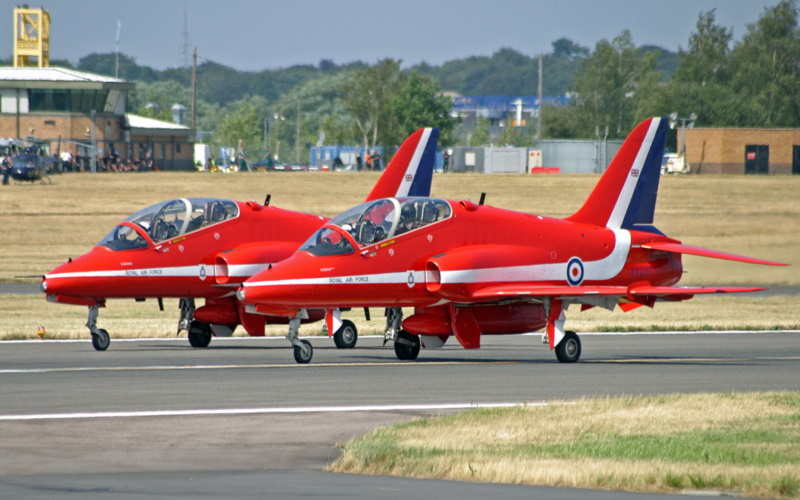
* Although British Hawks were obtained for the training mission, 88 of them were modified between 1983 and 1986 for a secondary air defense function through carriage of two US-built AIM-9L Sidewinder air-to-air missiles (AAMs). These Sidewinder-compatible Hawks were designated "T1A"; the Red Arrows fly the T1A, it seems on the rationale that if shooting were to suddenly break out, it might be wise for a group of some of the RAF's best pilots to be flying something they could fight with, though presumably not before their mounts got a quick new paint job to something less attention-getting than bright red. Other T1As were painted in the standard RAF air defense light gray color scheme. For simplicity, this document will not further distinguish between the T1 and the T1A.

British Hawks have now been in service for over two decades, and unsurprisingly upgrades have been performed. In the mid-1980s, the Hawks were suffering from levels of mechanical strain and fatigue far greater than expected, leading to a re-winging program that began in 1988 and ended in 1995. The shortened fatigue life was apparently not due to any flaw in design, but changes in training practice that increased stress on the aircraft. Another problem arose when a Hawk had a unfortunate dispute over right-of-way with a duck that demonstrated the windscreen wasn't hard enough. In 1986, an upgrade program was begun to install thicker windscreens. The RAF went on to obtain new-build Hawk trainers with modern "glass cockpits" and more powerful engines, see below.
* Along with aircraft upgrades, the RAF acquired simulator facilities to go along with their Hawks, opening the "Hawk Synthetic Training Facility" at RAF Valley in 2000. The facility was actually owned and operated by BAE Systems, with funding provided by the British government under a long-term contract arrangement.
The facility included a cockpit procedures trainer, a Hawk instrument flight simulator, and two full-dome flight simulators. The flight simulators included high resolution displays using a satellite imagery database, and could be linked with each other or with other compatible flight simulators. The simulator system reduced the amount of actual flight hours required in a training course, and also provided a safe environment for initial aircraft orientation preparatory to actual flight time. It has also been used by the Red Arrows for procedures training.
BACK_TO_TOP* HSA believed the Hawk would do well in the export market, projecting sales of a total of 1,000 aircraft over 20 years and scaling production capability accordingly. The "Hawk 50" export series featured an Adour 851 turbofan, an export version of the Adour 151 used in the British T1. The Hawk 50 also had a modified tailcone, two underwing pylons per wing, avionics improvements, the ability to carry larger drop tanks of 590-liter (156 US gallon) capacity, and was qualified for 30% greater take-off weight than the Hawk T1. The major potential competitor was the Dornier-Dassault Alpha Jet, which worryingly flew a year before the Hawk prototype. The Alpha Jet beat the Hawk in a large sale to Belgium, and in smaller sales to Togo and the Ivory Coast. The Alpha Jet appeared to have a lead at the time, and as a result HSA's engineering and marketing departments were not on good terms.
The Hawk's first breakthrough in international sales was in December 1977, when Finland placed an order for 50 "Hawk 51s" to replace their Fouga Magister trainers. The Finnish Hawk 51s had a unique avionics fit, used a Saab RS-2 gunsight, and were fitted with a VKT 12.7-millimeter (0.50-caliber) gun pod instead of the 30-millimeter Aden cannon pod carried by the T1. Interestingly, Finnish Hawks have sometimes carried Russian R-60 (AA-8 Aphid) heat-seeking AAMs; and they have also carried Vinten optical-infrared camera pods in the reconnaissance role.
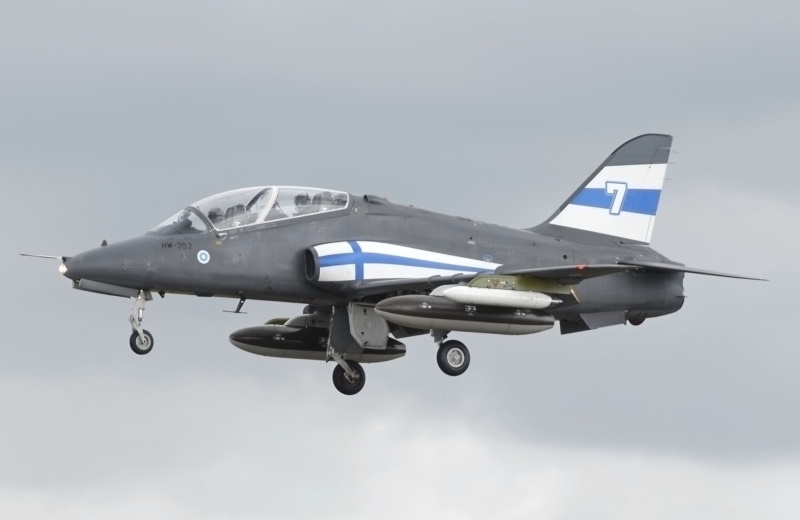
The first four Hawks in the Finnish order were built in the UK, with the other 46 assembled from kits by Valmet of Finland. The Finns bought seven more Hawks in 1990 to replace attrition. These new aircraft had minor refinements and were designated "Hawk 51A". All seven were built in the UK. In 2007, as discussed below, the Finns obtained 18 hand-me-down Hawks from Switzerland. Following the turn of the century the Finnish Hawks were clearly showing their age, and in 2006 a program was begun to update them, with modern avionics and a "glass cockpit". The first updated machine performed its initial flight in the fall of 2008, with the last update of 26 delivered in 2013.
In any case, the big 1977 Finnish order seemed to close the gap between the Hawk and the Alpha Jet, but in 1978 the Alpha Jet won orders in Morocco and Nigeria. However, BAE kept pace with a sale of twelve "Hawk 52s" for Kenya and eight "Hawk 53s" for Indonesia. The Indonesians eventually bought a total of 20 Hawks in four batches. The Kenyan Hawks were the first of the breed to be fitted with a drag chute, to reduce landing roll under "hot and high" conditions.
* In 1979, BAE decided to come up with an improved baseline "Hawk 60" export model, featuring the uprated Adour 861, with 25.4 kN (2,590 kgp / 5,710 lbf) thrust, and a slightly improved wing. The first sale was in early 1981, when Zimbabwe ordered eight Hawk 60s. These aircraft featured an enlarged drag chute. Only a few days after the first four arrived in country, however, insurgents threw explosive charges down their air intakes. One Hawk was completely wrecked; another was repaired in Zimbabwe; and the other two had to be shipped back to the UK for rebuild. In 1990, Zimbabwe ordered five improved "Hawk 60As".
In 1981, Dubai ordered eight "Hawk 61s" for training, light strike, and reconnaissance, using Vinten camera pods for the reconnaissance role. Dubai later bought an additional Hawk 61 as a replacement. These Hawk 61s were cleared for operation with French Matra Magic heatseeking AAMs. In 1982, Venezuela placed a large order for "Hawk 62s", but this deal fell through when the Falklands War broke out.
* After the Dubai sale, the Hawk proved very popular with other Middle Eastern countries. Abu Dhabi ordered 16 "Hawk 63s" in 1983, of which 14 were later upgraded to the "Hawk 63A" standard, featuring the further uprated Adour 871 engine with 26.24 kN (2,675 kgp / 5,900 lbf) thrust and a "combat wing", both of which were developed for the Hawk 100 and 200 operational combat variants of the Hawk series, described below. Abu Dhabi also ordered five "Hawk 63Cs" that were similar to the Hawk 63A, with deliveries in 1995.
Kuwait bought 12 "Hawk 64s" in 1983, which were cleared for operation with four AIM-9L Sidewinder AAMs. When Iraq invaded Kuwait in 1990, six of the Kuwaiti Hawks escaped to Bahrain and six were captured by the Iraqis. The Iraqis returned the six Hawks after their defeat in the Gulf War; the captured Hawks were unsurprisingly a little worse for wear after being in Iraqi custody, but they were refurbished with help from BAE and returned to flight status.
In 1985, Saudi Arabia ordered 30 "Hawk 65s", with improved wheels and brakes, followed in 1994 by an order for 20 Hawk 65As, which apparently were fitted with the Adour 871 and the combat wing. They fly with the Royal Saudi Air Force flight demonstration team, in very pretty green and white colors.
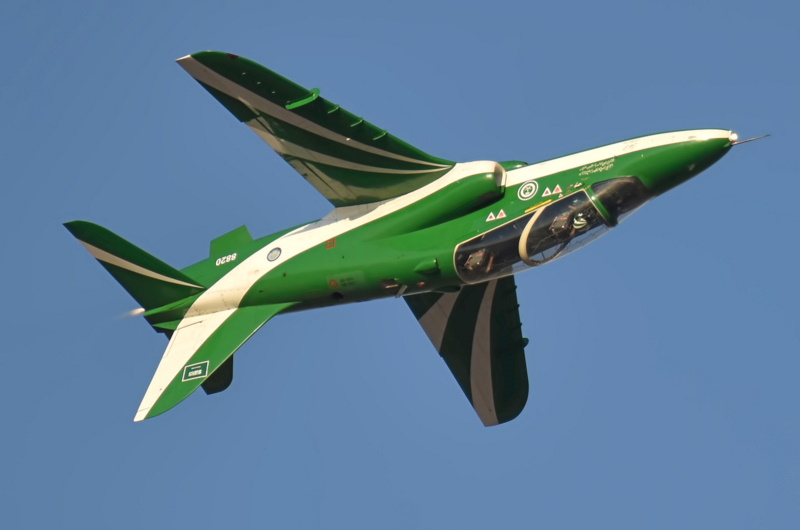
* Switzerland bought 20 "Hawk 66s" in 1987. Although that wasn't the biggest Hawk purchase by any means, it was a significant sale for BAE in terms of firmly establishing the Hawk's reputation. With the Swiss, no one could seriously suspect that corrupt practices had played any role in the aircraft's selection, and the Swiss tend to buy military aircraft as a long-term investment, to put it mildly, having been the very last military users of such classics as the Hawker Hunter and the De Havilland Vampire. In fact, the Hawks were bought to replace Vampire T.55 trainers. If the Swiss bought the Hawk, everyone knew that they had thought the matter over very carefully first.
The first aircraft in the Swiss batch was built in the UK and delivered, but the remainder were provided as kits that were assembled by the Swiss Federal Aircraft Factory in Emmen. They featured an Adour 861A-03 engine, with minor modifications relative to the standard Adour 861 to meet Swiss Air Force requirements. The Swiss Hawks provided advanced flight training after students acquired basic flight skills in Pilatus PC-7 turboprop trainers. The Swiss Hawks were given a crisp red and white color scheme, with the Swiss white cross insignia bringing a Swiss Army knife to mind, and so an informal label of "Swiss Army Jet". The Swiss apparently did not find the Hawk an entirely satisfactory investment, putting the fleet up for sale in 2002. As mentioned above, Finland bought 18 Swiss Hawks in 2007, giving them the same updates as Finnish Hawk 51 machines.
The Swiss order was followed in 1990 by a South Korean order for 20 "Hawk 67s", which featured a steerable nosewheel and a long nose. The long nose was derived from the Hawk 100, but did not accommodate the sensor suite of the Hawk 100, instead storing additional avionics and having a rounded end. The long, rounded nose gave the Hawk 67 a clearly unique appearance among all Hawk variants.
BACK_TO_TOP* If the Swiss purchase of the Hawk 66 was a promotional opportunity for BAE, it was overshadowed by an even more impressive win through a sale to the US Navy (USN) of a Hawk derivative, the "T-45 Goshawk", for the demanding role of carrier-based flight training. Not only was the USN a customer with generally high standards, but the Hawk had to go up against powerful American competitors who had a political edge.
The "Buy American" bias meant that BAE needed to have an American partner to front the deal, but fortunately BAE already had such a potential partner in the form of McDonnell Douglas Corporation (MDD -- now absorbed by Boeing). HSA had acquired a good relationship with MDD with license production of the Harrier, and this relationship carried over when HSA was swallowed up in BAE.
* In 1975, the USN began a study for a new carrier-capable jet trainer to replace the T-2C Buckeye and TA-4J Skyhawk. Capability was important, but procurement, operational, and life-cycle cost were emphasized. BAE pitched the Hawk to the USN in 1978, leading to a formal partnership agreement with MDD in 1980, and selection of the Hawk from a wide field of competitors in 1981.
However, the Hawk had never really been designed for carrier operations, and the T-45 Goshawk, as the USN trainer was designated, was by no means just another tweaky variant of the Hawk. Carrier operation meant more robust and wider landing gear with catapult attachment; an arresting hook; good low-speed flight characteristics; and other substantial changes. The changes were so extensive that the first of two Goshawk prototypes did not fly until 1988, the same year a production contract was awarded. USN evaluation of the initial prototype resulted in a long list of deficiencies that had to be corrected. Most of the items were nitpicky, but there was a small set of critical difficulties, which became known as "the Big Five".
Further delays were introduced by a decision to move production from the Douglas plant in California to the McDonnell plant in Saint Louis, Missouri. Carrier trials did not take place until 1991. Even then, the aircraft's troubles were not over, with one being lost in 1992 in a landing that went wildly wrong due to a landing gear defect, the pilot ejecting safely. All Goshawk prototypes were grounded until the problem was properly reviewed. Flight instruction with the Goshawk did not begin until 1994.
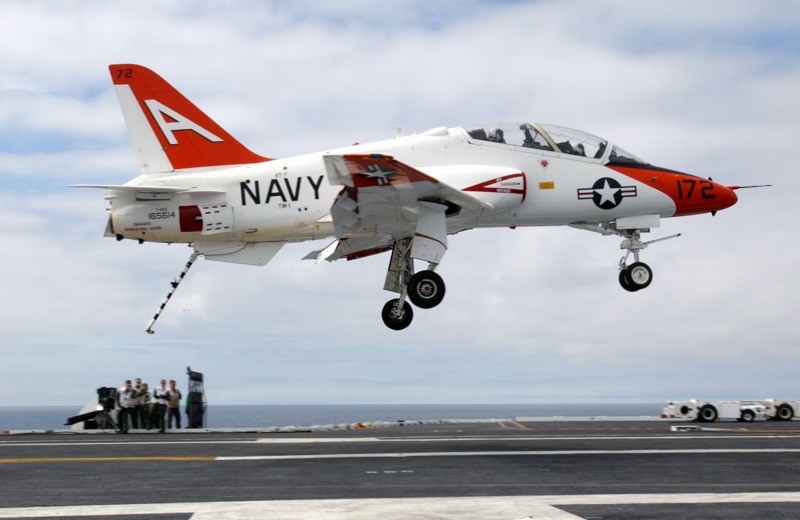
* The Goshawk was still clearly a Hawk, but was substantially modified Hawk and had clearly distinctive features. In the final production form, the changes included:
Engine fit for the Goshawk turned out to be a complicated issue. Lower-thrust versions of the Adour were considered at first to provide longer engine life, but unsurprisingly the changes made to the Hawk to produce the Goshawk substantially increased weight, and so the USN opted for a more powerful engine.
___________________________________________________________________
T-45 GOSHAWK:
___________________________________________________________________
wingspan:
9.39 meters (30 feet 10 inches)
wing area:
16.69 sq_meters (179.60 sq_feet)
length:
11.97 meters (39 feet 3 inches)
height:
4.27 meters (14 feet)
empty weight:
4,265 kilograms (9,400 pounds)
max loaded weight:
5,790 kilograms (12,760 pounds)
maximum speed:
1,000 KPH (620 MPH / 540 KT)
service ceiling:
12,875 meters (42,250 feet)
range (internal fuel):
1,850 kilometers (1,150 MI / 1,000 NMI)
___________________________________________________________________
In 1991, very late in the Hawk's development, the US Congress attempted to push the Navy to adopt the Garrett F124-GA100 turbofan engine, in order to steer more business to American industry. On paper, the F124 was a much more modern engine than the Adour, offering a higher thrust to weight ratio, longer life, and other advantages -- but the phrase "on paper" was critical, since no aircraft had been fitted with the new Garrett engine. Navy Goshawk program officials were appalled at the prospect of having to take another "zig" in a development program that had already had its fair share of "zags". After intense debate, the Secretary of the Navy ruled that the Goshawk would keep the Adour.
Interestingly, some sources claimed the Goshawk was not intended for weapons training and never carried a gun pack or stores pylons, but other sources claimed the Goshawk was qualified for stores carriage and release during development. Possibly the USN wanted to keep the option for weapons training, just in case it was needed at some time in the future.
* As it emerged, in flight the Goshawk looked much like any other Hawk trainer, but on carrier approach, with everything "down and dirty", the Goshawk looked very much a carrier aircraft, with its wide undercarriage spread open, leading-edge slats out, twin airbrakes extended, and arresting hook hanging down.
The Goshawk was built with Boeing as the prime contractor, BAE serving as the airframe subcontractor, and Rolls-Royce serving as the engine subcontractor. Boeing provided a "complete package" for Goshawk operations in the form of the "T-45 Training System", including maintenance, service, and a Hughes simulation system. Despite the delays and problems, the USN ended up very pleased with the end product. The very severity of the evaluation ensured that the Goshawk thoroughly satisfied their requirements.
The USN originally expected to acquire 302 Goshawks, but given the end of the Cold War, the total ended up being 221, not counting the two prototypes. The first 83 production Goshawks were T-45As, which were followed in 1997 by the "T-45C", with a digital glass cockpit layout featuring twin multifunction displays (MFDs); a head-up display (HUD); a Global Positioning System (GPS) satellite navigation receiver; and a MIL-STD 1553B digital data bus. The Goshawk was originally to have been fitted with a glass cockpit, but the USN had to drop that plan due to cost constraints. Later, the glass cockpit requirement was revived and implemented as a "Cockpit 21" effort in 1994, leading to the T-45C. Existing T-45As were upgraded to the T-45C standard.
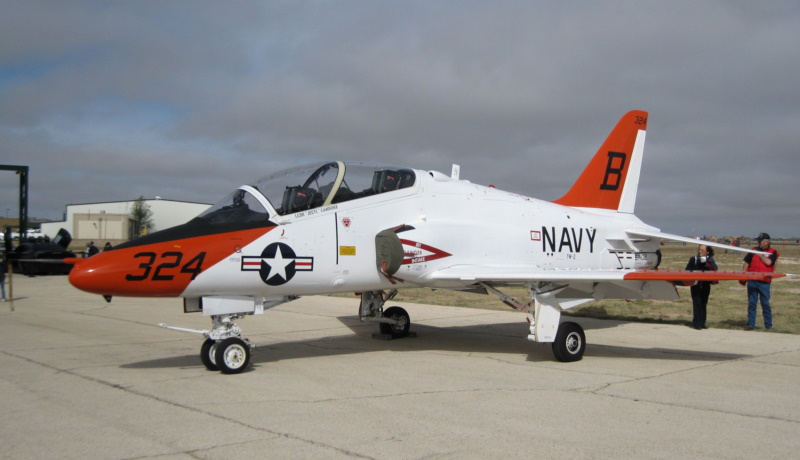
The reason why the variant designation jumped from T-45A to T-45C was because the USN had considered purchase of a proposed "T-45B" variant for a time, which would have been basically a conventional Hawk with a USN cockpit and no carrier capability. The USN had wanted the T-45B to get an earlier training capability, but abandoned the idea in 1984.
From 2022, the T-45Cs were refitted with new engine inlets, with a prominent forward sweep. The new inlets were intended to reduce the likelihood of dangerous engine compressor stalls and surges during aggressive maneuvers. Other ongoing improvements include updated avionics and cockpit displays; an Automatic Dependent Surveillance-Broadcast (ADS-B) air avoidance unit; and a new oxygen system. The effort to update the oxygen system was driven a series of incidents in which T-45 aircrew suffered from hypoxia-like symptoms. Boeing has been putting at least some of the older T-45s through a deep Service Life Extension Program (SLEP) overhaul, as well.
* The Navy is now considering a replacement for the Goshawk -- with the modern BAE Hawk seen as a contender. By the way, the reason the T-45 was given the name "Goshawk" instead of retaining the name "Hawk" was not out of any nationalistic desire to differ with the British; after all, the US adopted the Harrier from the British without a name change. The T-45 was named "Goshawk" to avoid confusion with the Hawk surface-to-air missile, another item in the US military inventory. Anybody who's ever been in any military organization knows that if a paperwork bungle is possible it will happen, and taking measures to avoid such difficulties is prudent.
BACK_TO_TOP* The Hawk had originally been designed as a trainer with a weapons training capability that could also be used as a light combat aircraft, but wasn't really suited for demanding combat duties. By 1981, BAE had investigated what needed to be done to turn the Hawk into a more formidable warbird, resulting in the "Enhanced Ground Attack (EGA) Hawk", which featured combat avionics borrowed from the US General Dynamics F-16 Fighting Falcon. BAE offered this variant to Venezuela in 1981, but the deal fell through.
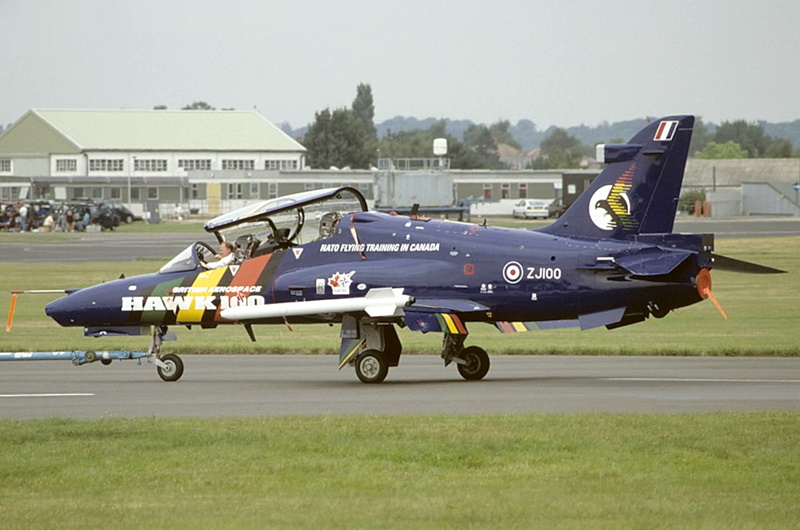
However, the idea wasn't dead by any means. The EGA Hawk emerged as the "Hawk 100" the next year, which featured:
The Hawk 100 demonstrator first flew in October 1987. While the Hawk 100 was at least as much warbird as trainer, BAE had also been considering, on an off-and-on basis, a single-seat Hawk that was all warbird, which emerged as the "Hawk 200". The first Hawk 200 demonstrator actually flew in May 1986, well before the Hawk 100 demonstrator, but was lost two months later in an accident that killed test pilot Jim Hawkins, who either became disoriented, or ironically blacked out while demonstrating the aircraft's agility.
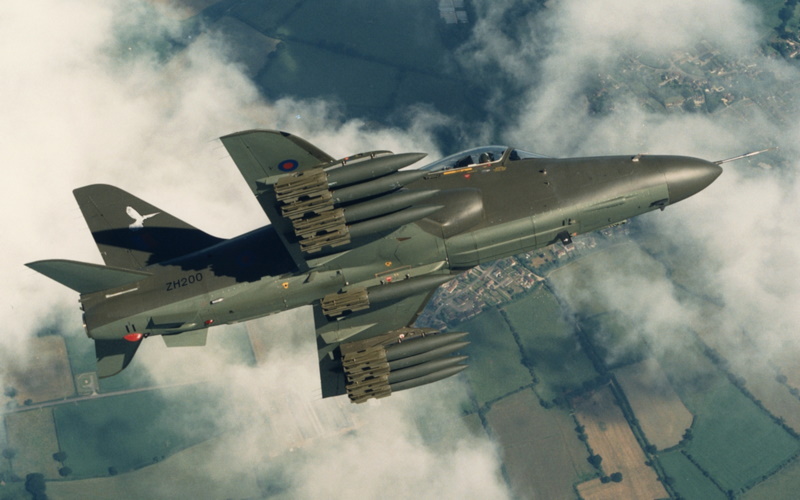
The Hawk 200 had the Adour 871 engine, combat wing, and some of the other combat kit of the Hawk 100, but along with the single seat configuration, which resulted in an entirely new fuselage from the cockpit forward, also featured a still taller tailfin; an optional fixed inflight refueling probe; and the Northrop-Grumman AN/APG-66H pulse-Doppler X-band multimode radar, with ten air-to-air and ten air-to-surface modes, derived from the AN/APG-66 used on the F-16A/B.
Cockpit layout was similar to that of the Hawk 100 to ease operational conversion. Interestingly, twin 25-millimeter Aden cannon were built into the nose of the Hawk 200 demonstrator, but production Hawk 200s used the 30-millimeter Aden cannon pack instead. It appears the 25-millimeter Aden cannon ran into significant development problems.
* Abu Dhabi was the first customer for the new, more warlike Hawks, placing an order of 18 "Hawk 102s" in 1990, with deliveries in 1993. In 1990, Oman bought a batch of four "Hawk 103s" and twelve "Hawk 203s", which were also delivered in 1993.

Malaysia ordered ten "Hawk 108s" and eighteen "Hawk 208s" in late 1990, which were delivered from 1993 through 1995. The Hawk 208s were the first Hawks to be sold with a flight refueling probe. In 1993, Indonesia ordered eight "Hawk 109s" and sixteen "Hawk 209s", with an option for 16 more Hawk 209s, which was exercised. All 40 new Indonesian Hawks were delivered by 1998.
In 1993, Australia selected the "Hawk 127" for an advanced fighter trainer requirement and ordered 33, with the first 12 to be delivered from the UK and the rest assembled in Australia from kits. Deliveries were in 2000 and 2001. The Hawk 127 featured cockpit kit compatible with the Boeing F/A-18 Hornet to provide training for Australian Hornet pilots. Interestingly, one of the losing competitors for this deal was the MDD T-45 Goshawk. From 2012, the Hawk 127s were given an update to permit them to better support training for Aussie F/A-18 Super Hornets and F-35s.
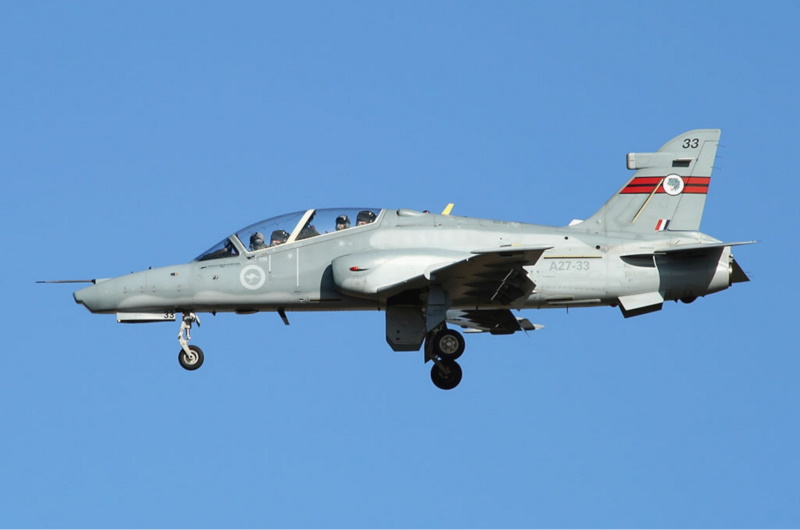
In a particularly intriguing deal, in 1997 the Hawk was selected for use in a Canadian "training for hire" scheme. The "NATO Flying Training in Canada (NFTC)" program is a joint venture of the Canadian government and Bombardier Aerospace Corporation, and offers its services to friendly governments on a contract basis. 18 "Hawk 115" trainers were initially ordered for NFTC, with an additional three trainers ordered in 2000 when Singapore signed up for the program. These Hawks were given a striking dark blue color scheme, with tail insignia consisting of a red Canadian maple leaf overlapped by a NATO four-pointed star. The Canadians gave them the designation of "CT-115". BAE was awarded an extended contract to provide repair and overhaul support for these aircraft. NFTC also operates 24 turboprop tandem seat Raytheon T-6A-1 Harvard II trainers for introductory flight instruction.
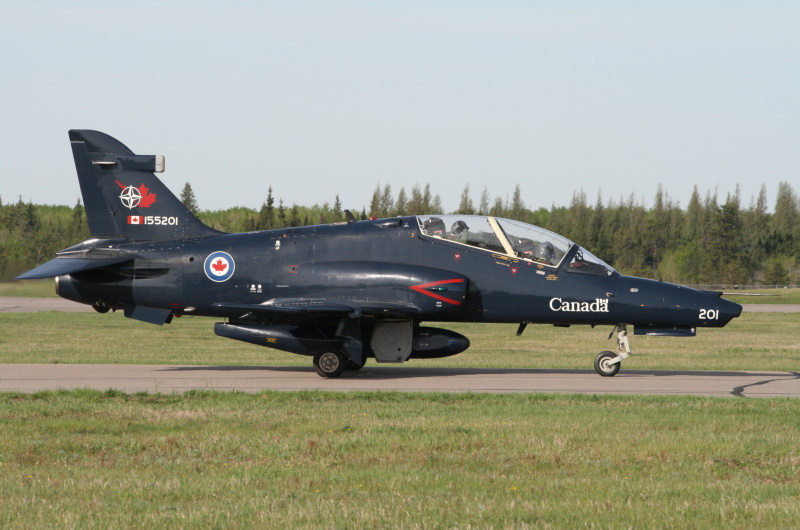
* BAE Systems went on to develop an improved trainer variant derived from the Australian Hawk 127 with the designation "Lead-In Fighter Trainer (LIFT)". The Hawk LIFT was intended to provide training for new-generation combat aircraft such as the Eurofighter Typhoon or Saab Gripen, and was accordingly given a substantially improved cockpit and avionics.
The Hawk LIFT's cockpit had three color flat-panel MFDs, HOTAS controls, and a HUD. Cockpit systems are tweaked as per customer request, for example providing HUD symbology consistent with the front-line aircraft for which flight training is conducted. The Hawk LIFT also featured a GPS-INS navigation system; a new AlliedSignal APU; an airframe "health & usage monitoring system (HUMS)"; two mission computers; and an optional inflight refueling probe. The Hawk LIFT also had several times the fatigue life of the Hawk T1.
___________________________________________________________________
HAWK LIFT:
___________________________________________________________________
wingspan (including Sidewinder AAMs):
9.94 meters (32 feet 7 inches)
wing area:
16.7 sq_meters (179.67 sq_feet)
length:
12.43 meters (40 feet 9 inches)
height:
3.98 meters (13 feet 1 inch)
empty weight:
4,400 kilograms (9,700 pounds)
max loaded weight:
9,100 kilograms (20,065 pounds)
maximum speed:
1,000 KPH (620 MPH / 540 KT)
service ceiling:
13,565 meters (44,500 feet)
range:
2,520 kilometers (1,565 MI / 1,360 NMI)
___________________________________________________________________
Rolls-Royce has offered an Adour 900 that could be used by Hawk LIFT, with exactly the same thrust as the existing Adour 871, but adding "full authority digital engine controls (FADEC)" and twice the lifetime of the Adour 871. Interestingly, Rolls-Royce was partly pushed towards the Adour 900 by the Garrett F124 flotch that arose late in the T-45 Goshawk's development program.
South Africa signed a deal with BAE in 1998 for 24 Hawk LIFTs, designated "Hawk 120". Sales went slow for a while after that, but in early 2003 Bahrain signed a deal for six Hawk 127 trainers. This was followed in the summer of 2003 by a bigger deal, when the British government also decided to buy new "Hawk 128" trainers, another variant of the Hawk LIFT series, to complement the current Hawk 1/1A machines. The old Hawks were still perfectly airworthy, but they had antique analog cockpits. The new machines had modern digital cockpits, making them more appropriate as trainers for RAF Eurofighter pilots, and had uprated and modernized Adour 951 engines. The initial order was for 20 aircraft, later increased to a total of 28, with initial deliveries as the "Hawk T2" in 2010.
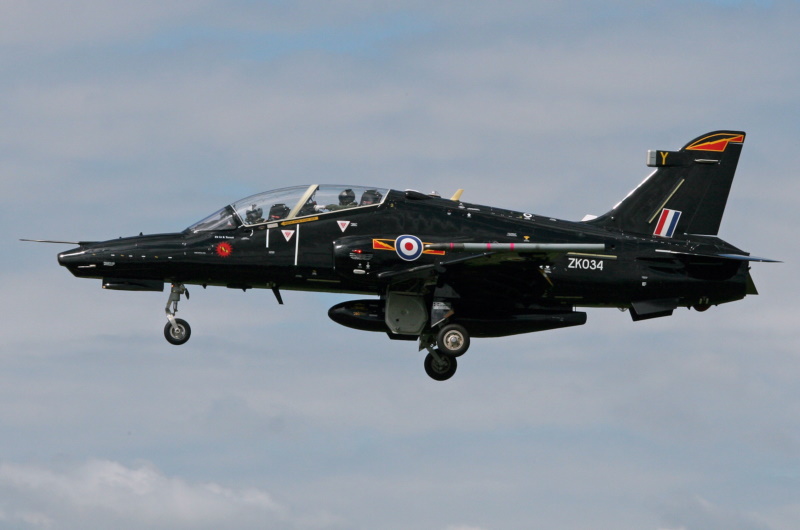
The British buy of new Hawks also knocked down the last obstacles to a buy of 66 Hawk LIFT machines as the "Hawk 132" AKA "Advanced Jet Trainers (AJT)" by the Indian Air Force (IAF). They were to replace IAF Hindustan Aerospace LTD (HAL) Kiran and PZL Iskra trainers. The deal had dragged out for almost two decades, being most recently delayed by sanctions imposed on India after that nation conducted nuclear tests in 1998, and then by war tensions with Pakistan. The first 24 were built by BAE, with the remaining 42 license-built by HAL in India.
First deliveries of BAE-built aircraft were in late 2007, with the first HAL-built machine delivered in the summer of 2008. All 24 British-made machines were delivered by the end of 2009, but there were delays in delivery of the HAL-built aircraft. A second order for 57 Hawk AJTs, all to be built by HAL, was placed in 2010, with 17 of these machines for the Indian Navy, not the IAF. From 2015, a program was set up between HAL and BAE to weaponize the Hawk AJTs, as a complement to India's SEPECAT Jaguar strike aircraft fleet. The first "Hawk-i" demonstrator took to the air in 2017, though the status of this effort is unclear.
In 2012, Oman ordered eight Hawk LIFT machines as the "Hawk 166", with deliveries in 2017. In 2018, Qatar agreed to buy nine Hawk LIFTs as the "Mark 167", the buy being part of a deal for 24 Eurofighter Typhoons. Deliveries were from 2022.
The Hawk has proven a great success. While the original projections of sales of 1,000 Hawks over 20 years didn't materialize, the actual sales have been nothing to be unhappy about -- and in fact sales of the Hawk far outpaced those of its early competitor, the Alpha Jet, which is now out of production while Hawks continue to roll off the manufacturing line. The Hawk is still being updated and refined to keep it in service, with combat Hawks having been qualified for new munitions, such as the Brimstone anti-armor missile and ASRAAM AAM.
Avionics are also being kept up-to-date; one particularly interesting effort is to fit Hawks with "augmented reality" gear to permit in-flight simulation training. BAE Systems has tinkered with an "Advanced Hawk" with a modified wing featuring leading-edge slats, a head-mounted display, and a single large-screen display, though it hasn't been more than a concept yet.
BACK_TO_TOP* The following list gives Hawk variants and production:
That gives a total of 765 BAE Hawks produced. Add to that 206 T-45 Goshawks, that gives Hawk production as 960 aircraft.

* Sources include:
* Illustration credits:
* Revision history:
v1.0 / 01 jun 00 v1.0.1 / 01 apr 02 / Review & polish. v1.0.2 / 01 apr 04 / Review & polish. v1.0.3 / 01 mar 06 / Review & polish. v1.0.4 / 01 feb 08 / Review & polish. v1.0.5 / 01 jan 10 / Review & polish. v1.0.6 / 01 dec 11 / Review & polish. v1.0.7 / 01 nov 13 / Review & polish. v1.1.0 / 01 oct 15 / Fixed production table. v1.1.1 / 01 sep 17 / Review & polish. v1.1.2 / 01 aug 19 / Review & polish. v1.2.0 / 01 sep 21 / Illustrations update. v1.2.1 / 01 aug 23 / Review & polish.BACK_TO_TOP
